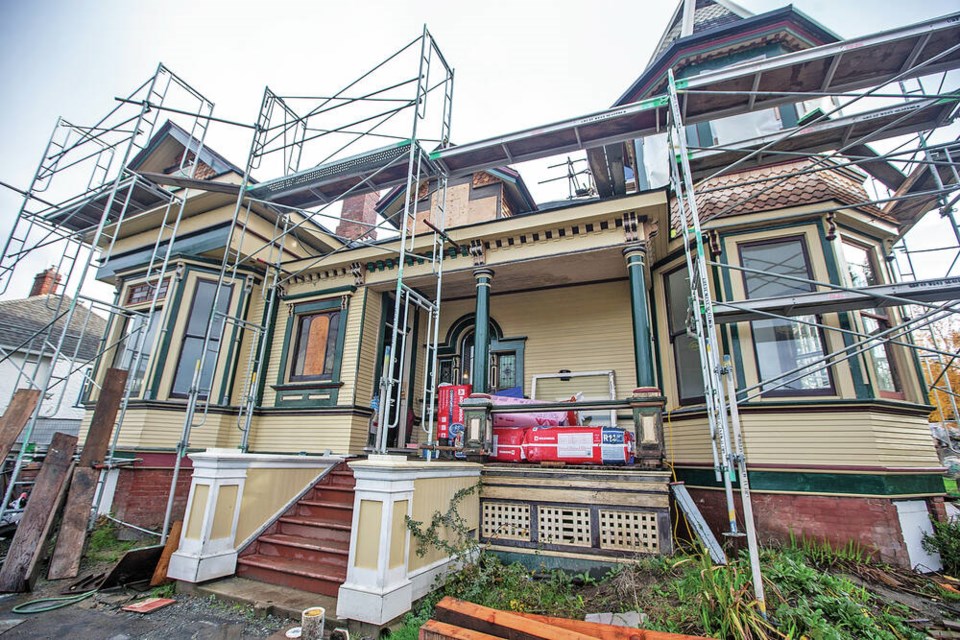Jim Lee has spent the last 47 years restoring his Victorian-style house in Vic West. The one-and-a-half storey home on Robert Street is a national historic site and shares the block with houses similarly built in the late 1800s and early 1900s.
With new owners moving into the neighbourhood during the last few years, Lee became concerned about potential development changing the character of the street and set his sights on turning a section of the block into a heritage conservation area to guide future changes.
“It’s keeping a neighbourly feel to the street, with houses that are in scale with each other,” he said.
Lee nominated a section of Robert Street for designation by the city as a heritage conservation area, which would make external changes to existing houses and new builds subject to certain criteria. Victoria councillors voted last month to hold a public hearing on the proposal.
The city has 13 heritage conservation areas, including downtown and five small pockets of single-family homes in residential neighbourhoods, such as Battery Street near Beacon Hill Park.
If approved, Robert Street would become the first heritage conservation area in the city created through a citizen-led process.
The section of Robert Street to be considered has 14 one-storey and one-and-a-half storey houses, four of which were built during the Victorian and Edwardian era, between 1888 and 1911, in a style known as Queen Anne and Colonial Bungalow, said John O’Reilly, Victoria’s senior heritage planner.
The elaborate detailing of the homes contrasts with others on the street that were built from 1939 to 1943 in minimal traditional style with two-tone colour schemes, smooth stucco walls and simply designed doors and windows.
O’Reilly said the street shows the evolution of the single-family home from exclusive abodes to simpler houses funded under Canada’s first national housing legislation, aimed at middle-class families in the wartime and post-war era.
It also shows the transformation of Vic West from large homes on expansive properties to an industrial area surrounded by suburbs for the working class, he said.
Residents who would be affected by the heritage conservation area were largely supportive of the idea during the most recent consultation meeting in May, O’Reilly said. The city mailed out 16 surveys on the topic in December 2018, and nine came back in favour, three were opposed and four did not respond, he said.
If the proposal is approved after a public hearing, expected in early spring, it will bring restrictions on external changes for some homeowners.
Owners of four of the houses that are already designated as heritage properties would experience no changes.
Five homes within the proposed area did not meet the threshold for historical significance, so owners of those homes could demolish or alter the buildings without needing to meet heritage criteria. Any new build would need to work within design guidelines to fit with the area, however.
The main structure of the remaining five homes would need to be conserved, but owners can make minor changes to the exterior without seeking a heritage alteration permit, such as repainting, adding an addition up to 1,000 square feet and adding solar panels.
“The city is trying to protect what’s visible from the street,” O’Reilly said, as well as the scale of the houses.
The heritage designation does not impose limits on how many households can occupy a home, or prohibit building garden suites in the backyard. Two of the heritage-designated houses already contain four rental or strata units.
Coun. Jeremy Loveday, who was the Vic West neighbourhood liaison during the early stages of the proposal, said the hope was that Robert Street would serve as a pilot project to show the city and residents how to create future heritage conservation areas. He said he’s heard criticism that creating heritage conservation areas works against the city’s effort to build more affordable housing, but he believes there’s space for both policies.
“I think that these two, these different efforts can work together to provide a vibrant city that preserves some important heritage while making space for everyone to have access to living within traditionally single-family neighborhoods,” he said.
Dave Thompson, a public policy research consultant, currently working on housing policy, said he sees the value in conserving areas with interesting architectural styles that tell a story, and he doesn’t think a heritage designation in such a small area would have an impact on housing supply. Applying it on a broader scale, however, could exacerbate existing affordability issues, he said.
“I would be concerned if heritage were used as a way to sort of cripple the addition of homes across Victoria,” said Thompson, who plans to run for Victoria council in next year’s election.
City staff are also studying an area in James Bay nominated by residents to become a heritage conservation area. O’Reilly expects it will take about a year for staff to determine whether Lewis Street, home to century-old houses in a variety of styles, meets the criteria of historical significance.
regan-elliott@timescolonist.com



